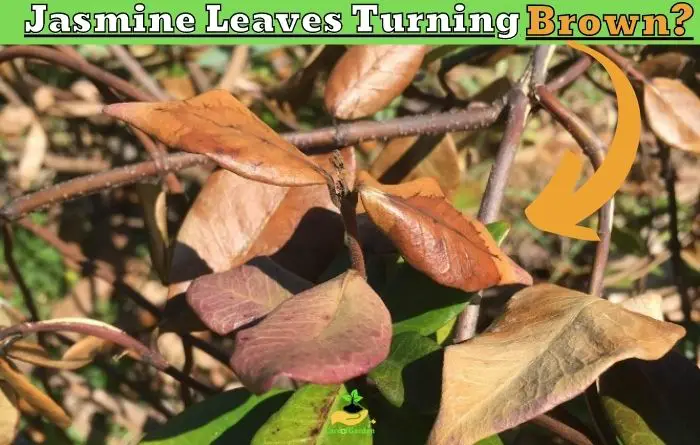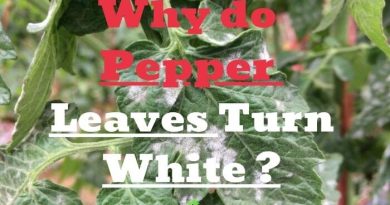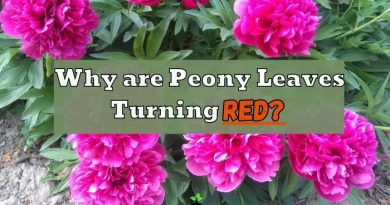Jasmine Leaves Turning Brown: 6 Expert Reasons Revealed!
I planted a jasmine shrub last fall, and lately, I’ve noticed the leaves, once vibrant green, are turning brown. It’s a worrying sight that makes you wonder: why are my jasmine leaves turning brown?
Brown jasmine leaves can be caused by factors like inadequate watering, nutrient deficiencies, pests/diseases, or excessive sunlight. To prevent brown leaves, ensure your jasmine plant is getting the right amount of water, sunlight, and nutrients. Keep an eye out for pests and diseases, and take action promptly.
| Causes of Jasmine Leaves Turning Brown |
|---|
| 1. Watering issues |
| 2. Environmental stress |
| 3. Nutrient deficiency |
| 4. Pests and diseases |
| 5. Lack of pruning and maintenance |
| 6. Herbicide damage |
Common Causes of Jasmine Leaves Turning Brown
In this section, we will explore the various factors that can lead to jasmine leaves turning brown and provide insights into how to remedy these problems.
1. Watering issues
From my experience, one of the primary culprits behind brown jasmine leaves is improper watering. Both overwatering and underwatering can have detrimental effects on the plant’s health.
Overwatering
Jasmine plants use the roots to absorb water from the soil in order to provide moisture and nutrients to the leaves, and when the soil around the roots is constantly wet due to overwatering.
Overwatering can result in root rot as the excess moisture suffocates its roots and prevents oxygen from reaching them. This, in turn, hinders jasmine’s ability to take up water and nutrients properly, leading to brown leaves.
Over time, the leaves may become wilted, feel soft or mushy, and develop brown or yellow patches.
Treatment
Adjust your watering practices by allowing the soil to dry out slightly between waterings and ensuring proper drainage. Avoid letting the jasmine plant sit in standing water and consider using a well-draining potting mix.
Underwatering
As we already know, water is essential for plants to survive and carry out their main functions. But when jasmine doesn’t get enough water, it starts to become dehydrated, which can lead to the browning of the leaves.
Jasmine has tiny openings called stomata, which are like little mouths that allow plants to take in carbon dioxide and release oxygen. These stomata also play a role in regulating the plant’s water balance.
When there isn’t enough water available, the stomata start to close up to conserve the water inside. This closure prevents the exchange of gases, and the plant can’t take in enough carbon dioxide for photosynthesis—the process that helps plants make food.
When jasmine can’t produce the food (energy) it needs to keep its leaves healthy and green it will start turning its leaves brown, which eventually will wither and dry out if nothing is done to prevent it.
Treatment
To address this issue, water your jasmine thoroughly, making sure that the water reaches the root zone. Check the moisture level of the soil regularly and water the plant when the top inch of soil feels dry.
Additionally, consider using mulch around the base of the plant to retain moisture and provide some insulation.
2. Environmental stress
Jasmine plants are sensitive to changes in their environment. Exposure to extreme temperatures and inadequate lighting conditions can cause leaves to turn brown.
Temperature extremes
Cold drafts or hot, dry air can stress the plant and lead to browning of the leaves. Protect your jasmine plant from cold drafts by avoiding placing it in areas with fluctuating temperatures or near doors and windows.
Treatment
During colder months, provide proper insulation, such as by moving the plant to a warmer location or covering it with a plant cover. Similarly, shield the plant from direct exposure to hot, intense sunlight, which can cause leaf scorching.
Consider placing the plant in a location with consistent temperatures and providing adequate ventilation.
Lighting conditions
Insufficient or excessive light causes damage to their leaves, resulting in leaf discoloration. Jasmine plants thrive in bright, indirect light.
Excessive sunlight can lead to a process called photoinhibition, where the plant’s photosynthetic machinery becomes overwhelmed. As a result, the leaves may start to show signs of stress, such as browning or scorched patches.
Also, excess sunlight causes damage to the chlorophyll pigment of the jasmine which is responsible for the green color of the leaves. When the chlorophyll gets damaged or destroyed, the leaves lose their green color and turn brown.
Treatment
If your jasmine is not receiving enough light, consider moving it to a location with better lighting conditions, such as closer to a window or under grow lights.
Conversely, if the plant is exposed to too much direct sunlight, provide some shade or filter the light using curtains or sheer blinds to prevent leaf damage.
3. Nutrient Deficiency
Lack of essential nutrients in the soil can lead to brown leaves in jasmine plants. Several key nutrients play crucial roles in the jasmine’s growth and development.
| Nutrient Deficiency | Symptoms | Treatment Options |
|---|---|---|
| Nitrogen (N) | Older leaves turn pale green or yellow, then brown and drop. | Apply a balanced fertilizer with a higher nitrogen content. Incorporate organic matter into the soil. |
| Phosphorus (P) | Leaves turn dark green, develop reddish or purple discoloration, and may eventually turn brown and curl. | Apply a phosphorus-rich fertilizer. Adjust the pH of the soil if it is too alkaline, as phosphorus availability decreases in alkaline soils. |
| Potassium (K) | Leaf margins turn brown or yellow, starting from the tips, with scorched or necrotic leaf tips. Overall leaf growth is stunted. | Apply a fertilizer with a higher potassium content. Ensure proper drainage to prevent potassium leaching. |
| Magnesium (Mg) | Older leaves turn yellow between the veins, progressing to brown coloration. | Apply magnesium sulfate (Epsom salt) or a fertilizer containing magnesium. Adjust the soil pH if it is too acidic, as magnesium availability decreases in acidic soils. |
| Iron (Fe) | Younger leaves turn yellow with a brown or bronze color. | Apply iron chelate or iron sulfate to the soil. Adjust soil pH if it is too alkaline, as iron availability decreases in alkaline soils. |
| Manganese (Mn) | Symptoms similar to iron deficiency, with interveinal chlorosis in young leaves. Leaf tissue between veins may develop brown or necrotic spots. | Apply manganese sulfate to the soil. Foliar sprays with manganese-containing fertilizers can also be used. |
Sources: https://edis.ifas.ufl.edu/publication/EP362
Nitrogen deficiency
For jasmine plants experiencing nitrogen deficiency, it is important to apply a nitrogen-rich fertilizer specifically formulated for flowering plants. This will help replenish the lacking nutrients and promote healthy leaf development.
To determine the recommended dosage, I would suggest referring to the instructions provided on the fertilizer package. As a general guideline, I would recommend applying the fertilizer at a rate of 1 tablespoon per square foot of soil.
It is best to repeat the application every 4-6 weeks during the growing season. However, it is important to exercise caution and not exceed the recommended dosage, as excessive nitrogen can lead to other complications.
Iron deficiency
Iron deficiency often manifests as interveinal chlorosis in jasmine plants, where the veins of the leaves retain their green color while the areas between them turn yellow or brown.
Treatment
I would recommend treating the soil with iron chelates or incorporating iron-rich organic amendments. The dosage of iron chelates may vary depending on the specific product chosen.
It is advisable to follow the instructions provided by the manufacturer to determine the appropriate dosage and application frequency. Typically, iron chelates are applied at a rate of 1-2 tablespoons per gallon of water.
The resulting solution can then be applied to the soil around the base of the plant, facilitating the absorption of iron and rectifying the deficiency.
Magnesium deficiency
Insufficient magnesium levels can result in brown spots or marginal leaf burn on jasmine plants.
To address this deficiency, I would recommend applying magnesium sulfate, commonly known as Epsom salt. Dissolve 1-2 tablespoons of Epsom salt in a gallon of water and apply the solution to the soil around the base of the plant.
Alternatively, you can opt for fertilizer containing magnesium. These fertilizers typically come with dosage instructions on the packaging, which should be followed accordingly.
Providing the necessary dosage of magnesium will help alleviate the deficiency symptoms and promote healthier foliage.
Potassium deficiency
Lack of potassium in jasmine plants often leads to yellowing and browning of leaf edges. To rectify this issue, I would suggest applying a potassium-rich fertilizer. The recommended dosage may vary depending on the specific product chosen.
As a general guideline, I would recommend applying the fertilizer at a rate of 1-2 tablespoons per gallon of water or as specified on the packaging. Applying the solution to the soil around the base of the plant will ensure proper absorption of potassium and help restore the plant’s overall health.
To determine the nutrient levels accurately, I highly recommend conducting a soil test. This test will provide valuable insights into the specific deficiencies and guide the adjustment of the fertilization regimen accordingly.
Remember, the goal is to achieve an optimal nutrient balance without over-fertilizing, as excessive nutrient levels can lead to other problems detrimental to the jasmine plant.
By following these guidelines and providing the appropriate doses of nutrients, you can support the healthy growth and vibrant appearance of your jasmine plants.
4. Pests and Diseases
Jasmine plants are susceptible to various pests and diseases, which can cause stress and lead to leaf browning.
Pest infestations
Common pests such as spider mites, aphids, and whiteflies feed on the leaves and suck out the jasmine sap, damaging the foliage, resulting in brown, withered leaves.
To control these pests, consider using organic insecticidal soaps or horticultural oils. Regularly inspect your plants for any signs of pest infestations and take immediate action to prevent further damage.
Pests can also introduce toxins or transmit diseases that further contribute to leaf discoloration.
| Pest | Symptoms | Treatment Options |
|---|---|---|
| Spider Mites | Leaves develop yellow stippling or speckling, which progresses to brown or bronze discoloration. Fine webbing may be visible. | Rinse plants with a strong jet of water to dislodge mites. Apply insecticidal soap or neem oil to control severe infestations. Maintain proper humidity levels and avoid over-fertilization. |
| Aphids | Leaves become distorted and curled. Presence of small, soft-bodied insects on the undersides of leaves. Honeydew (a sticky substance) may be present. | Spray plants with a strong jet of water to remove aphids. Apply insecticidal soap or neem oil for persistent infestations. Encourage natural predators like ladybugs. |
| Mealybugs | White, cottony insects congregate on stems and leaf axils. Leaves may turn yellow and develop brown spots or areas of discoloration. | Remove mealybugs by hand or with a cotton swab dipped in rubbing alcohol. Apply insecticidal soap or neem oil to control severe infestations. |
https://www.gardeningknowhow.com/ornamental/flowers/jasmine/jasmine-pest-control.htm
Fungal infections
Fungal diseases like powdery mildew and leaf spot can affect jasmine plants and cause browning of the leaves. These diseases thrive in humid conditions and can spread rapidly if not addressed promptly.
To combat fungal infections, ensure proper air circulation around the plant and avoid overhead watering, as it promotes moisture on the leaves. Applying fungicides specifically formulated for the particular disease can also help control the infection.
| Disease | Jasmine Symptoms | Treatment Options |
|---|---|---|
| Fungal Diseases (e.g., Powdery Mildew) | Leaves develop a powdery, white or grayish coating. As the disease progresses, affected leaves turn brown and may become distorted or necrotic. | Improve air circulation around plants. Remove and dispose of infected jasmine parts. Apply fungicides labeled for powdery mildew control. Avoid overhead watering and maintain proper spacing between plants. |
| Bacterial Leaf Spot | Irregular brown spots with yellow halos appear on jasmine leaves. Spots may enlarge and merge, causing leaves to turn brown and eventually drop. | Remove and destroy infected leaves. Avoid overhead watering and provide good air circulation. Apply copper-based fungicides labeled for bacterial leaf spot control. |
| Root Rot | Leaves turn yellow, wilt, and eventually turn brown. Roots may appear dark, mushy, or have a foul odor. | Improve drainage and avoid overwatering. Ensure jasmine are planted in well-draining soil. Use sterile planting material. Apply fungicides labeled for root rot control. |
| Leaf Blight | Irregular brown spots or lesions appear on leaves, often surrounded by a yellow halo. Spots may enlarge, causing leaves to turn brown and die. | Remove and dispose of infected leaves. Maintain good air circulation and avoid overhead watering. Apply fungicides labeled for leaf blight control. |
Bacterial infections
Bacterial infections, such as bacterial leaf spot, can lead to the development of brown spots on the leaves. These infections often occur when jasmine is exposed to excessive moisture or is injured by pruning or other means.
Treatment
To prevent bacterial infections, practice good sanitation by removing and disposing of infected plant material. Avoid overhead watering and minimize plant injuries. If necessary, apply copper-based bactericides to help control the spread of the infection.
It is crucial to monitor your jasmine shrubs regularly for any signs of pests or diseases. Early detection and intervention can prevent significant damage and the browning of leaves.
5. Lack of Pruning and Maintenance
Improper pruning techniques or neglecting essential maintenance practices can also contribute to jasmine leaves turning brown.
Improper pruning
Pruning is essential to maintain the health and shape of the jasmine shrub. However, incorrect pruning methods, such as excessive or aggressive pruning, can stress the plant and cause leaf browning.
Treatment
To avoid this issue, learn proper pruning techniques for jasmine plants. Prune selectively, removing dead or diseased branches, and shape the plant gradually over time.
Lack of maintenance
Neglecting basic maintenance tasks like removing dead leaves and debris can create a favorable environment for pests and diseases, leading to leaf browning. Additionally, overcrowding and lack of proper spacing between plants can hinder air circulation and promote the spread of diseases.
Treatment
Regularly inspect your plants and remove any dead or diseased leaves. Keep the area around the plants clean and tidy, and provide adequate spacing between individual plants to promote healthy growth.
6. Herbicide damage
Herbicides help control weeds in home gardens, but they can damage jasmine. One way chemicals such as herbicides, pesticides, or excessive amounts of fertilizer can cause jasmine leaves to turn brown is by damaging their plant tissues.
When jasmine plants are exposed to chemicals, they can absorb these substances through their leaves or roots.
They disrupt the balance of water and nutrients within the plant, affecting its ability to take up essential nutrients and water from the soil. This imbalance can result in stress and dehydration, leading to the browning and drying out of the leaves.
Chemicals can also interfere with the plant’s ability to carry out photosynthesis, the process that allows plants to convert sunlight into energy.
They will disrupt jasmine chlorophyll production, the pigment responsible for the green color of leaves, and hinder its ability to absorb light. As a result, the leaves may lose their green color and turn brown.
Treatment
Take care to protect jasmine plants from accidental spray drift and avoid using chemicals in excessive amounts.
It is essential to follow proper application techniques and use chemicals specifically formulated for jasmine or other desired plants to avoid chemical exposure and its detrimental effects on their foliage.
How to prevent brown leaves on jasmine
Here are some tips and strategies for you to prevent jasmine leaves from turning brown:
1. Regular Pruning: Trim your jasmine plant regularly to promote healthy growth and prevent overcrowding. Remove any dead or yellowing leaves to maintain overall plant health.
2. Pest control: Keep an eye out for common pests like aphids, spider mites, and whiteflies. Inspect your jasmine plant regularly and take immediate action if you spot any infestations. Use organic insecticides or natural remedies to avoid damaging the plant.
3. Avoid extreme temperatures: Jasmine plants prefer moderate temperatures, so keep them away from drafts or extreme cold or heat. Sudden temperature changes can cause leaf discoloration and stress your jasmine shrub. Provide insulation or move potted plants indoors during harsh weather conditions.
4. Proper airflow: Ensure adequate air circulation around your jasmine plant, as poor airflow can lead to fungal diseases and leaf browning. Avoid overcrowding and prune any dense branches or foliage that restrict airflow.
5. Consistent care: Be consistent with your care routine for jasmine plants. Stick to a regular watering schedule, monitor nutrient levels, and provide appropriate sunlight and shade. Avoid sudden changes in care practices, as they can cause stress and lead to leaf browning.
Follow these tips to maintain healthy jasmine foliage and prevent browning leaves. With proper care, your jasmine plants will thrive and enhance the beauty of your garden or indoor space.
Frequently Asked Questions
Indoor jasmine plants may turn brown due to a few common reasons. First, insufficient sunlight can lead to leaf browning. Ensure your indoor jasmine is placed in a well-lit area or consider using artificial grow lights to provide the necessary light exposure. Second, overwatering is a frequent culprit. Avoid keeping the soil overly wet and allow the top inch to dry out between waterings. Adequate drainage is essential.
Jasmine plants can be susceptible to pests like spider mites, aphids, or diseases like fungal infections. Inspect the leaves for signs of infestation or infection and apply appropriate treatments.
Overwatering can cause brown, wilted leaves, while underwatering leads to dry, crispy brown leaves. Check the moisture level of the soil and adjust your watering accordingly.
Jasmine leaves may turn brown in winter due to dormancy, dry indoor conditions, reduced light, or improper watering. Winter dormancy is a natural process, causing leaf discoloration. Dry indoor air and insufficient light can contribute to moisture loss and stress, leading to browning. Adjust watering, increase humidity, and ensure proper light exposure for healthier leaves.




